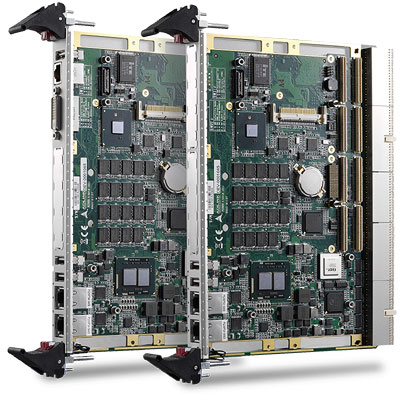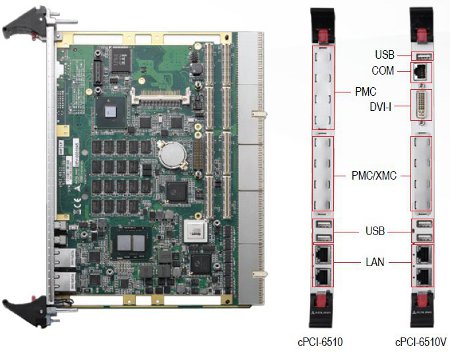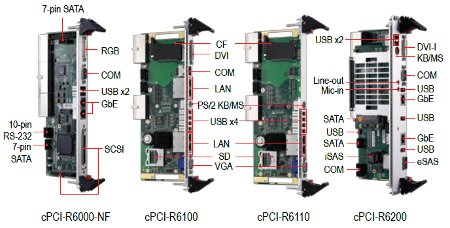CompactPCI board takes on Core i7
Jul 30, 2010 — by Eric Brown — from the LinuxDevices Archive — 7 viewsAdlink Technology announced a 6U CompactPCI processor blade equipped with 32nm, dual-core Intel Core i7 CPU models ranging up to the 2.53GHz i7-610E. The cPCI-6510 Series incorporates two PMC sites and a PCIe site, and is available in a multitude of versions varying by processor model, I/O, storage options, and temperature range.
Featuring all soldered components, the cPCI-6510 Series targets military, transportation, aviation and communications applications, says Adlink. Like the recently announced Kontron CP6002, which aims at similar markets, the cPCI-6510 adopts the 6U CompactPCI format, as well as the 32nm Intel Core i7.

I/O-rich cPCI-6510V (left) and standard cPCI-6510 model (right)
The Core i7 processors are touted for their high performance-per-watt ratio, four-thread computing capability, and integrated, high-performance graphics.
Earlier this year, Adlink announced a cPCI-6920 6U CompactPCI blade that runs on the earlier 45nm, dual-or quad-core Xeon processor. This year, the company also introduced a series of Intel Atom-based 3U CompactPCI blades called the cPCI-3610 Series.
The cPCI-6510 supports up to 8GB of dual-channel, soldered DDR3-1066 SDRAM, and is equipped with the Intel QM57 Platform Controller Hub, says Adlink. A CompactFlash socket is also said to be available.
The cPCI-6510 supplies two PMC sites using a PCI 64bit/133MHz bus, as well as one PCI Express x8 XMC site that shares the same space as the inner PMC site, says Adlink. The blades also come with a variety of rear transition module (RTM) options, with variations in I/O and storage options (see farther below).
A cPCI-6510V version occupies one of the PMC sites with a 2.5-inch SATA hard disk drive or flash disk. It also offers additional front-facing I/O.

Adlink cPCI-6510 (middle) and cPCI-6510V (right)
The standard temperature range is said to be 32 to 140 deg. F (0 to 60 deg. C). All the versions also offer 20G, 11ms-duration shock resistance, as well as 2-Grms vibration resistance.
All the cPCI-6510 models provide four gigabit Ethernet ports, including two front-facing ports, and the cPCI-R6100 RTM option adds a fifth port. The standard model provides two USB 2.0 ports on the front panel, while the V versions add a third port. Meanwhile, six more USB ports are routed to the RTM.
Two serial ports come standard, with a third added to the V models, says Adlink. A PS/1 port is routed to the RTM, as are high definition audio signals, says the company.
Two DVI channels are provided for video, with one routed to the front, and the other to the rear, with DVI-I ports optional, but only the V models get a DVI-I port as standard. In addition, all the models offer a QXGA analog signal, said to be switchable to either the front or rear.

Rear transition module options
Other standard features are said to include LEDs, a coin-cell battery, a watchdog timer, and a hardware monitor. In addition to supporting the PICMG 2.0 CompactPCI R3.0, standard, the blade supports PICMG standards for hot swap, system management, and packet switching backplane features, says the company.
Stated Eric Kao, senior manager of Adlink's Modular Computing Product Center, "The cPCI-6510 provides intelligent performance with power efficiency and is ideally suited for applications in mission critical environments requiring data-intensive performance, high reliability and low power consumption."
Availability
Adlink did not offer pricing on the now available cPCI-6510 Series, which supports Linux, Windows XP, Windows 7, and VxWorks. A rugged, conduction-cooled version of the board called the CT-61, offering identical electronic design, will be ready in the third quarter.
More information on the cPCI-6510 Series may be found here, and the datasheet in PDF format may be found here.
This article was originally published on LinuxDevices.com and has been donated to the open source community by QuinStreet Inc. Please visit LinuxToday.com for up-to-date news and articles about Linux and open source.